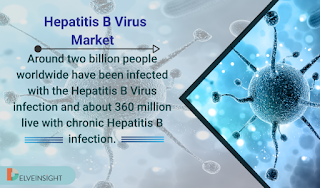Dry Eye Disease Market Research Report 2030 | Dry Eye Disease Market
What is Dry Eye Disease?
Dry eye disease
is a common condition that happens when your tears aren't able to provide
adequate lubrication for your eyes. Tears are often inadequate and unstable for
several reasons. For instance, dry eyes may occur if you do not produce enough
tears or if you produce poor-quality tears.
DelveInsight's
new launch on "Dry
Eye Disease Market report 2030” delivers an in-depth understanding of
the Dry Eye Disease, historical and forecasted epidemiology also as the Dry Eye
Disease market trends within the 7MM.
Dry eyes feel
uncomfortable. If you've got dry eyes, your eyes may sting or burn. You'll
experience dry eyes in certain situations, like in an air-conditioned room,
while riding a motorcycle or after watching a display screen for a couple of
hours.
Dry
Eye Disease Signs and symptoms, which usually may affect both eyes, may
include:
- A burning or scratchy sensation in your eyes
- Sensitivity to light
- Eye redness
- Difficulty wearing contact lenses
- Watery eyes
- Eye fatigue
Request for sample pages of the report: https://www.delveinsight.com/sample-request/dry-eye-disease-market-insights
Dry Eye Disease Treatment Therapies and Options
For most people
with occasional or mild dry eye symptoms, it's enough to regularly use
over-the-counter eye drops. If your symptoms are persistent and more serious,
you've got other options.
Prescription medications used to treat dry eyes
include:
●
Drugs
to reduce eyelid inflammation
●
Eye-drops
to control cornea inflammation
●
Tear-stimulating
drugs
Other procedures that may be used to treat dry
eyes include:
●
Closing
your tear ducts to reduce tear loss
●
Using
special contact lenses
●
Unblocking
oil glands
●
Using
light therapy and eyelid massage
The Dry
Eye Disease market report 2030 provides Dry Eye Disease treatment
algorithms and therapies in the 7mm.
Dry Eye Disease Epidemiology Insights
One study found
that 17 percent of 2,127 patients visiting a hospital in Japan were diagnosed
with dry eyes, while 14.6 percent in a group of 2,520 older individuals
reported symptoms of dry eyes. Dry eye syndrome can occur at any age, and in
otherwise healthy people.
●
According
to a study, the general Dry Eye Disease prevalence
was 5.28%, wherein the prevalence among females and males was about 7.78% and
2.96%, respectively,
●
The
overall Dry Eye Disease prevalence between 2003 and 2015, estimated among
approximately 9.7 million MHS beneficiaries, was 5.28%.
●
Overall
prevalence was higher among females (7.78%) than male beneficiaries (2.96%) and
increased with age.
This section of
the DelveInsight Dry
Eye Disease report also includes information on the diagnosed patient
pool, trends, and assumptions used.
For each of the
seven major countries, the Dry Eye Disease epidemiology section provides
information on historical and present Dry Eye Disease patient pools, as well as
predicted trends.
Got queries? Click here to read more about Dry
Eye Disease Market Trends
Dry Eye Disease Market Insights
The treatments of
Dry Eye Disease are varied. The goals of treatment are to alleviate the
symptoms of dry eye, improve the patient’s comfort, return the ocular surface
and tear film to the traditional state, and, whenever possible, prevent corneal
damage.
Key Insights:
●
Many
companies are involved within the ongoing research, which is aimed toward
achieving more detailed knowledge of inflammatory pathways and targeting
various sorts of inflammatory mediators in dry eye patients.
●
Recent
advances within the understanding of tear film physiology and pathology have
allowed the formulation of a spread of tear substitutes capable of addressing
specific deficiencies of tear components.
●
Key
players, like Oyster Point Pharma, Kala
Pharmaceuticals, Ocugen, Topivert, Aurinia Pharmaceuticals, Novaliq, and
lots of others are involved in developing therapies for Dry Eye Disease, they're expected to vary the market
scenario of Dry disease within the upcoming years.
By assessing the
impact of current medicines on the market, unmet needs, drivers and barriers,
and demand for better technologies, the Dry Eye Disease market outlook report
helps to establish a complete understanding of historic, present, and future Dry
Eye Disease market trends.
According to
DelveInsight, the Dry
Eye Disease market in 7MM is expected to change in the study period
2017-2030.
Dry Eye Disease Emerging Therapy Assessment
- OC-01/OC-02 : Oyster
Point Pharma
- OCU 310 : Ocugen
- HMB9036 : HanAll
Biopharma
- MC2-03 : mc2
therapeutics
- ECF843 : Novartis
- Voclosporin ophthalmic
solution : Aurinia Pharmaceuticals
- KPI-121 : Kala
Pharmaceuticals
OC-01/OC-02: Oyster
Point Pharma
Oyster Point
Pharma is developing a lead product candidate, OC-01 which is a highly
selective nAChR agonist and is being developed for the treatment of signs and
symptoms of Dry Eye Disease.
MC2-03: mc2 therapeutics
Using PAD
Technology, Mc2 therapeutics is developing MC2-03 which is a new cyclosporine
eye drop that's designed to uniquely improve the delivery of cyclosporine into
the eyes using a vehicle/eye drop that's highly tolerable.
ECF843: Novartis
ECF843 is a
recombinant human lubricin protein, developed by Lubris LLC, in-licensed by
Novartis. It's a new therapeutic approach and potential first-in-class
treatment in dry-eye, which may be a small phase II clinical trial study that
showed the potential to produce instant relief of symptoms.
The emerging
therapy assessment segment of the Dry
Eye Disease report encloses a detailed analysis of Dry Eye Disease
marketed drugs and late-stage pipeline drugs.
Visit our repository of reports @ DelveInsight Report Store
About DelveInsight
DelveInsight is a leading Business Consultant and Market
Research Firm focused exclusively on life sciences. It supports pharma
companies by providing end-to-end comprehensive solutions to improve their
performance.


Comments
Post a Comment